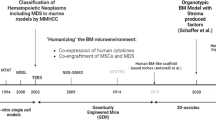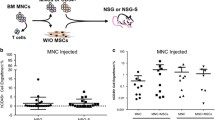Abstract
Myelodysplastic syndrome (MDS) consists of a group of hematologic tumors that are derived from the clonal proliferation of hematopoietic stem cells, featuring abnormal hematopoietic cell development and ineffective hematopoiesis. Animal models are an important scientific research platform that has been widely applied in the research of human diseases, especially tumors. Animal models with MDS can simulate characteristic human genetic variations and tumor phenotypes. They also provide a reliable platform for the exploration of the pathogenesis and diagnostic markers of MDS as well as for a drug efficacy evaluation. This paper reviews the research status of three animal models and a new spontaneous mouse model with MDS.
Similar content being viewed by others
Data availability
The datasets used and/or analyzed during the current study available from the corresponding author on reasonable request. We declared that materials described in the manuscript, including all relevant raw data will be freely available to any scientist wishing to use them for non-commercial purposes, without breaching participant confidentiality.
References
Cazzola M. Myelodysplastic syndromes. New Engl J Med. 2020;10(1):1358–74.
Hasserjian RP, Orazi A, Brunning R, et al. Myelodysplastic syndromes: overview. In: Swerdlow SH, Campo E, Harris NL, et al., editors. WHO classification of tumors of haematopoietic and lymphoid tissues. Lyon, France: International Agency for Research on Cancer; 2017. p. 98–106.
Epstein-Peterson ZD, Spitzer B, Derkach A, et al. De Novo myelodysplastic syndromes in patients 20–50 years old are enriched for adverse risk features. Leuk Res. 2022;117: 106857.
Li W, Li M, Yang X, et al. Summary of animal models of myelodysplastic syndrome. Anim Models Expr Med. 2021;4:71–6.
Beachy SH, Aplan PD. Mouse models of myelodysplastic syndromes. Hematol Oncol Clin North Am. 2010;24(2):361–75.
Das M, Chaudhuri S, Law S. Benzene exposure–an experimental machinery for induction of myelodysplastic syndrome: stem cell and stem cell niche analysis in the bone marrow. J Stem Cells. 2012;7(1):43–59.
Luo YW, Tong HY. Research advances in related etiology of myelodysplastic syndrome. Chin J Pract Intern Med. 2017;37(03):267–70.
Leone G, Pagano L, Ben-Yehuda D, et al. Therapy-related leukemia and myelodysplasia: susceptibility and incidence. Haematologica. 2007;92(10):1389–98.
Nucifora G, Laricchia-Robbio L, Senyuk V. EVI1 and hematopoietic disorders: history and perspectives. Gene. 2006;368:1–11.
Raza A, Buonamici S, Lisak L, et al. Arsenic trioxide and thalidomide combination produces multi-lineage haematological responses in myelodysplastic syndromes patients, particularly in those with high pre-therapy EVI1 expression. Leuk Res. 2004;28:791–803.
Buonamici S, Li D, Chi Y, et al. EVI1 induces myelodysplastic syndrome in mice. J Clin Investig. 2004;114:713.
Laricchia-Robbio L, Premanand K, Rinaldi CR, et al. EVI1 Impairs myelopoiesis by deregulation of PU.1 function. Cancer Res. 2009;69:1633.
Padua RA, McGlynn A, McGlynn H. Molecular, cytogenetic and genetic abnormalities in MDS and secondary AML. Cancer Treat Res. 2001;108:111–57.
Zinkel SS, Ong CC, Ferguson DO, et al. Proapoptotic BID is required for myeloid homeostasis and tumor suppression. Genes Dev. 2003;17:229–39.
Omidvar N, Kogan S, Beurlet S, et al. BCL-2 and mutant NRAS interact physically and functionally in a mouse model of progressive myelodysplasia. Cancer Res. 2007;67(24):11657–67.
Christiansen DH, Andersen MK, Pedersen-Bjergaard J. Mutations of AML1 are common in therapy-related myelodysplasia following therapy with alkylating agents and are significantly associated with deletion or loss of chromosome arm 7q and with subsequent leukemic transformation. Blood. 2004;104:1474–81.
Watanabe-Okochi N, Kitaura J, Ono R, et al. AML1 mutations induced MDS and MDS/AML in a mouse BMT model. Blood. 2008;111:4297.
Damen JE, Liu L, Cutler RL, Krystal G. Erythropoietin stimulates the tyrosine phosphorylation of Shc and its association with Grb2 and a 145-Kd tyrosine phosphorylated protein. Blood. 1993;82:2296–303.
Liu Q, Sasaki T, Kozieradzki I, et al. SHIP is a negative regulator of growth factor receptor-mediated PKB/Akt activation and myeloid cell survival. Genes Dev. 1999;13:786.
Helgason CD, Damen JE, Rosten P, et al. Targeted disruption of SHIP leads to hemopoietic perturbations, lung pathology, and a shortened life span. Genes Dev. 1998;12:1610.
Grisendi S, Mecucci C, Falini B. Pandolfi pp. Nucleophosmin cancer Nat Rev Cancer. 2006;6:493–505.
Grisendi S, Bernardi R, Rossi M, et al. Role of nucleophosmin in embryonic development and tumorigenesis. Nature. 2005;437:147.
Goessling W, North TE, Loewer S, et al. Genetic interaction of PGE2 and Wnt signaling regulates developmental specification of stem cells and regeneration. Cell. 2009;136(6):1136–47.
Lane SW, Sykes SM, Al-Shahrour F, et al. The Apc(min) mouse has altered hematopoietic stem cell function and provides a model for MPD/MDS. Blood. 2010;115(17):3489–97.
Stoddart A, Wang J, Hu C, Fernald AA, Davis EM, Cheng JX, Le Beau MM. Inhibition of WNT signaling in the bone marrow niche prevents the development of MDS in the Apcdel/+ MDS mouse model. Blood. 2017;129(22):2959–70.
Garcia-Domingo D, et al. DIO-1 is a gene involved in onset of apoptosis in vitro, whose misexpression disrupts limb development. Proc Natl Acad Sci U S A. 1999;96:7992–7.
Futterer A, Campanero MR, Leonardo E, et al. Dido gene expression alterations are implicated in the induction of hematological myeloid neoplasms. J Clin Invest. 2005;115:2351.
Slape C, Aplan PD. The role of NUP98 gene fusions in hematologic malignancy. Leuk Lymphoma. 2004;45:1341–50.
Pineault N, Buske C, Feuring-Buske M, Abramovich C, Rosten P, Hogge DE, Aplan PD, Humphries RK. Induction of acute myeloid leukemia in mice by the human leukemia-specific fusion gene NUP98-HOXD13 in concert with Meis1. Blood. 2003;101(11):4529–38.
Lin YW, Slape C, Zhang Z, et al. NUP98-HOXD13 transgenic mice develop a highly penetrant, severe myelodysplastic syndrome that progresses to acute leukemia. Blood. 2005;106:287.
Chung YJ, Khawaja G, Wolcott KM, Aplan PD. Use of hematopoietic stem cell transplantation to assess the origin of myelodysplastic syndrome. J Vis Expr. 2018;140:58140.
Shields BJ, Slape CI, Vo N, Jackson JT, Pliego-Zamora A, Ranasinghe H, Shi W, Curtis DJ, McCormack MP. The NUP98-HOXD13 fusion oncogene induces thymocyte self-renewal via Lmo2/Lyl1. Leukemia. 2019;33(8):1868–80.
Chen BY, Song J, Hu CL, Chen SB, Zhang Q, Xu CH, Wu JC, Hou D, Sun M, Zhang YL, Liu N, Yu PC, Liu P, Zong LJ, Zhang JY, Dai RF, Lan F, Huang QH, Zhang SJ, Nimer SD, Chen Z, Chen SJ, Sun XJ, Wang L. SETD2 deficiency accelerates MDS-associated leukemogenesis via S100a9 in NHD13 mice and predicts poor prognosis in MDS. Blood. 2020;135(25):2271–85.
Al-Baradie R, Yamada K, St Hilaire C, et al. Duane radial ray syndrome (Okihiro syndrome) maps to 20q13 and results from mutations in SALL4, a new member of the SAL family. Am J Hum Genet. 2002;71:1195–9.
Ma Y, Cui W, Yang J, Qu J, Di C, Amin HM, Lai R, Ritz J, Krause DS, Chai L. SALL4, a novel oncogene, is constitutively expressed in human acute myeloid leukemia (AML) and induces AML in transgenic mice. Blood. 2006;108(8):2726–35.
Wu MY, Eldin KW, Beaudet AL. Identification of chromatin remodeling genes Arid4a and Arid4b as leukemia suppressor genes. J Natl Cancer Inst. 2008;100:1247.
Chen ML, Logan TD, Hochberg ML, et al. Erythroid dysplasia, megaloblastic anemia, and impaired lymphopoiesis arising from mitochondrial dysfunction. Blood. 2009;114(19):4045–53.
Steube KG, Gignac SM, Hu ZB, Teepe D, Harms D, Kabisch H, Gaedicke G, Hansen-Hagge T, Macleod RA, Quentmeier H, Drexler HG. In vitro culture studies of childhood myelodysplastic syndrome: establishment of the cell line MUTZ-1. Leuk Lymphoma. 1997;25(3–4):345–63. https://doi.org/10.3109/10428199709114174 (PMID: 9168445).
Nilsson L, Astrand-Grundstrom I, Anderson K, et al. Involvement and functional impairment of the CD34(+)CD38(-)Thy-1(+) hematopoietic stem cell pool in myelodysplastic syndromes with trisomy 8. Blood. 2002;100(1):259–67.
Benito AI, Bryant E, Loken MR, et al. NOD/SCID mice transplanted with marrow from patients with myelodysplastic syndrome (MDS) show long-term propagation of normal but not clonal human precursors. Leuk Res. 2003;27(5):425–36.
Guo YF, Xu KX, Hong JW, Yin S, Niu X, Feng QJ, et al. Analysis of phytochemical constituents of zuogui wan in rat serum and its effects on early embryonic development of mice. World J Tradit Chin Med. 2020;6:324–30.
Thanopoulou E, Cashman J, Kakagianne T, Eaves A, Zoumbos N, Eaves C. Engraftment of NOD/SCID-beta2 microglobulin null mice with multilineage neoplastic cells from patients with myelodysplastic syndrome. Blood. 2004;103(11):4285–93. https://doi.org/10.1182/blood-2003-09-3192 (Epub 2004 Feb 12 PMID: 14962905).
Krevvata M, Shan X, Zhou C, Dos Santos C, Habineza Ndikuyeze G, Secreto A, Glover J, Trotman W, Brake-Silla G, Nunez-Cruz S, Wertheim G, Ra HJ, Griffiths E, Papachristou C, Danet-Desnoyers G, Carroll M. Cytokines increase engraftment of human acute myeloid leukemia cells in immunocompromised mice but not engraftment of human myelodysplastic syndrome cells. Haematologica. 2018;103(6):959–71.
Li W, Cao L, Li M, Yang X, Zhang W, Song Z, Wang X, Zhang L, Morahan G, Qin C, Gao R. Novel spontaneous myelodysplastic syndrome mouse model. Animal Model Expr Med. 2021;4(2):169–80.
Fohlmeister I, Schaefer HE, Fischer R. On the pathogenesis of preleukemic myelodysplastic syndrome. Cancer Res Clin Oncol. 1982;104:249–61.
Serenella EC, Willy K, Christopher B, et al. Prognosis and predictive significance of erbB-2 breast tumou levels measured by enzyme immunoassay. J Clin Oncol. 2001;19(3):645–56.
Feng BZ, Zhao TF, Wang SQ, Wang XY, Lei JL, Yang CL. Establishment and characterization of a rat model for myelodysplastic syndrome induced by DMBA. J Expr Hematol. 1996;4(3):309–13.
Basu S, Sachidanandan C. Zebrafish: a multifaceted tool for chemical biologists. Chem Rev. 2013;113(10):7952–80.
Orkin SH, Zon LI. Hematopoiesis: an evolving paradigm for stem cell biology. Cell. 2008;132(4):631–44.
Wei N, Pang W, Wang Y, et al. Knockdown of PU.1 mRNA and AS lncRNA regulates expression of immune-related genes in zebrafish Danio rerio. Dev Comp Immunol. 2014;44(2):315–9.
Yaqoob N, Holotta M, Prem C, et al. Ontogenetic development of erythropoiesis can be studied non-invasively in GATA-1: DsRed transgenic zebrafish. Comp Biochem Physiol A. 2009;154(2):270–8.
Zhang A, Wu M, Tan JL, et al. Establishment of a zebrafish hematological disease model induced by 1,4-benzoquinone. Dis Model Mech. 2019;12(3):37903–18.
Yang YY, He C, Zhang R, Tang JF. Research progress of zebrafish model in hematologic tumor diseases. Biotechnology. 2021;31(4):402–9.
Nathan J, Kannan RR. Antiangiogenic molecules from marine actinomycetes and the importance of using zebrafish model in cancer research. Heliyon. 2020;6(12):662–72.
Liu W, Wu M, et al. c-myb hyperactivity leads to myeloid and lymphoid malignancies in zebrafish. Leukemia. 2017;31(1):222–33.
Acknowledgements
We would like to acknowledge the hard and dedicated work of all the staff who implemented the intervention and evaluation components of the study.
Funding
This work was supported by Young and Middle-aged Teachers Education Research Project of Fujian Province (Technology) (No. JAT210104).
Author information
Authors and Affiliations
Contributions
Conception and design of the research: GWC and CMF. Writing of the manuscript: GWC and MNC. Critical revision of the manuscript for intellectual: CMF, YZC, LL, YYZ, JPW, SSG, and RFH. All the authors read and approved the final draft.
Corresponding author
Ethics declarations
Conflict of interest
The authors declare that they have no competing interests.
Ethical approval
Not applicable.
Consent to participate
Not applicable.
Consent for publication
Not applicable.
Additional information
Publisher's Note
Springer Nature remains neutral with regard to jurisdictional claims in published maps and institutional affiliations.
Rights and permissions
Springer Nature or its licensor holds exclusive rights to this article under a publishing agreement with the author(s) or other rightsholder(s); author self-archiving of the accepted manuscript version of this article is solely governed by the terms of such publishing agreement and applicable law.
About this article
Cite this article
Chen, GW., Chen, MN., Liu, L. et al. A research review of experimental animal models with myelodysplastic syndrome. Clin Transl Oncol 25, 105–113 (2023). https://doi.org/10.1007/s12094-022-02931-7
Received:
Accepted:
Published:
Issue Date:
DOI: https://doi.org/10.1007/s12094-022-02931-7




